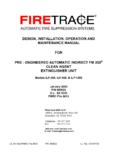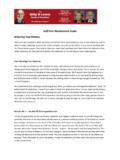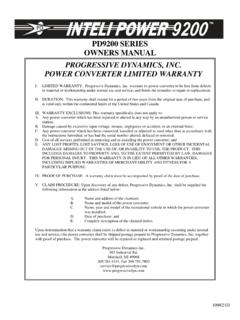Transcription of 200004 Marine/RV Battery Maintenance - InTech …
1 MARINE/RVBATTERYMAINTENANCEMAXIMIZING CYCLING PERFORMANCEB1 Table of Contents An Introduction to Marine/RV Deep-Cycle Batteries 2 Battery Terms Deep-Cycle Batteries 2 Flooded Lead-Acid Batteries 2 Sealed Lead-Acid Batteries 3 Proper Deep-Cycle Application 3 Cycles 3 Cycle Types: Shallow, Moderate, Deep 4 Cycle Life 4 Determining Depth of Discharge/State of Charge 5 Surface Charge 5 Ratings and Specifications 6 Charging 7 Don t Overcharge or Overheat 8 Choosing a Charger 8 Trickle Charging 9 Frequently Asked Questions 10 Types of Battery Connections 15 Interstate s Marine/RV Starting Batteries 17 Typical Applications 17HD24-DPSRM-24 PRO-24 MGC2-XHD23 Sealed Lead-Acid BatteriesYou ll see these batteries described as Maintenance -free because there are no vent caps and no liquid levels to check. For electrolyte, these batteries use either gel cell or absorbed glass-mat technology, and they don t expel gases such as hy-drogen and oxygen during recharge . (They combine the gases internally).
2 AGM and gel batteries are completely sealed and free of corrosion, and their design is ideal when the Battery bank is hard to Deep-Cycle ApplicationA Marine/RV deep-cycle Battery can be used for various applications including boats, motor homes, sailboats, travel trailers and tent campers. Remember, if you need repeated deep discharge, choose a Marine/RV deep-cycle term cycle refers to one Battery discharge and recharge of any depth. The term depth of discharge refers to the amount of the Battery discharge (in percent) compared with its full capacity, and that percentage indicates the need for a shallow, moderate or deep cycle. For example, 40% depth-of-discharge indicates that a Battery has been discharged by 40% of its total capacity and has a 60% state of charge Introduction to Marine/ RV Deep-Cycle BatteriesAll batteries, even those marketed as Maintenance -free, need some level of Maintenance , whether it s a periodic cleaning and tightening of the terminals, trickle charging after winter or a touch-up of the water level.
3 This booklet is designed to help you understand how to get the most from your Marine/RV deep-cycle batteries. Battery TermsDeep-Cycle BatteriesDeep-cycle batteries are designed discharge power at a slow rate for an extended period of time. For marine applications, they re built to provide power for your trolling motor and other accessories, like fish-finders, whether or not your engine is running. In RV applications, deep-cycle batteries power the comforts of home, like your cooking appliances and vs. Starting or Cranking Different kinds of batteries deliver different kinds of perfor-mance. A starting or cranking Battery , for example, is made specifically to provide a quick burst of energy thousands of times in its lifetime while deep-cycle batteries are made to be discharged deeply hundreds of times. A starting Battery will only handle about 50 deep-discharge cycles during its life. Any time an application indicates a need for batteries that can provide repeated deep discharging, you should choose a deep-cycle Lead-Acid BatteriesYou ll find two kinds of Marine/RV lead-acid batteries: flooded and sealed.
4 A flooded Battery has a liquid electrolyte and vent caps to allow for Maintenance . Maintenance on a flooded Battery includes checking the electrolyte levels and adding distilled water when necessary. These batteries are best used when the Battery bank is easily Battery CYCLETIME OF OPERATIONREDUCEDCAPACITYFULLCHARGE FIGURE 145To optimize the performance of a Marine/RV deep-cycle Battery , we recommend that the consistent discharge level not fall below 50%. Of course, many other factors also affect Battery cycle life. If your Battery is used in a high heat environ-ment (consistently above 90 F), the number of cycles it may provide in its total service life could be drastically Depth of Discharge/State of ChargeA Battery s depth of discharge is the opposite of its state of charge. For example, a Battery with a 30% depth of discharge has a 70% state of charge. The most efficient way to determine the state of charge on a flooded lead-acid Battery with removable vent caps is to use a hydrometer.
5 For Maintenance -free batteries, we recommend you use an accurate digital STATE OF CHARGE GRAVITYVOLTAGESPECIFIC GRAVITYSTATE OF CHARGEDEPTH OF 4 Surface Charge Surface charge refers to an inflated charge level immediately after the Battery has been charged. Lead-acid batteries charge slowly, and most of the charge activities occur on the surfaces of the plates. Immediately after charging and before things normalize, the plate surfaces will hold a higher state of charge than the rest of the Battery . As a result, you re likely to see an inflated charge level if you use a voltmeter too soon after charging. Even though your voltmeter may tell you the Battery measures volts, it may not actually be fully charged. To remove Battery surface charge, apply a load of 10-15 Amps for two to three minutes, then allow the Battery to sit for one minute before Types: Shallow, Moderate, DeepThere are three primary types of Battery discharge cycles. Shallow cycles occur when only a small percentage of the total Battery capacity is discharged.
6 Moderate or deep cycles use a higher percentage of the Battery s total capacity. (See Figure 2.)TYPES OF CYCLESFIGURE 2 Cycle LifeA Battery s cycle life is how many cycles the Battery produces in its lifetime. Cycle life depends on many variables, including Maintenance , proper recharge , depth of discharge, Battery tem-perature, cycling use, vibration and overall care and consider-ation. Because of the variables, cycle life is difficult to of the more important factors is how deeply the Battery gets discharged each cycle. As the depth of discharge increases, the Battery s total cycle life decreases (See Figure 3). For example, if a Battery is regularly discharged to 100% depth of discharge (assuming all other variables stay the same), the Battery s total cycle life reduces to much less than half of a Battery that s regularly discharged to only 50%.APPROXIMATE LIFE CYCLEPERFORMANCE (DEEP-CYCLE Battery )% DEPTH OF DISCHARGECYCLES TO 50% CAPACITY25220050100075550100250 Typical performance at 80 F (cycles halfed per 18 F rise).
7 Discharged to volts/cell. End of life at 50% 367 APPROXIMATE HOURS AT AMPERE LOAD5 AMPS10 AMPS15 AMPS20 AMPS25 5 ChargingOne of the best ways to enhance the service life and perfor-mance of your Battery is to follow proper charging methods. Always choose a charger specifically designed to match the charging requirements (voltage and current) of the Battery or Battery pack. If you have an onboard charger unit like an alternator, generator or converter, validate its compatibility with any new Battery before you : Flooded and sealed batteries often use different chargers. Make sure your charger is specifically designed for your Battery and SpecificationsMarine/RV deep-cycle batteries have rating specifications that may look like alphabet soup. Here s a quick rundown of what those terms on the Battery label Cranking Amps (CCA)CCA is the amount of current (in Amps) a Battery at 0 F ( C) can deliver for 30 seconds while maintaining at least volts per cell ( volts for a 12-volt Battery ).
8 Marine Cranking Amps (MCA)MCA is the amount of current (in Amps) a Battery tested at 32 F (0 C) can deliver for 30 seconds and maintain at least volts per cell ( volts on a 12-volt Battery ). Reserve Capacity (RC)RC is the amount of time a Battery can deliver 25 Amps at 80 F ( C) without falling below volts per cell ( volts on a 12-volt Battery ). Note: Interstate Batteries uses the RC rating established by Battery Council International (BCI). Some manufacturers use a 15- or 23-Amp discharge rate rather than 25-Amp discharge. The lower discharge level means they can show a higher RC rating on the Battery s label. Don t be fooled; those numbers do not reflect the true RC minutes at a 25-Amp hours (Ah)Tested at 80 F, it s the amount of current (in Amps) that a Battery can deliver, multiplied by the amount of hours, without falling below volts per cell ( volts on a 12-volt Battery ). Most Marine/RV deep-cycle batteries are rated on a 20-hour discharge rate. For example: A 100 Ah Battery can deliver five Amps for 20 hours (Amps x hours = Ah).
9 89 Pay attention to timing. Select a charger with a capacity sufficient to fully recharge the batteries within eight to 12 hours. Choose Maintenance -free chargers when possible: A charger that automatically shuts off after a certain time or when the Battery reaches a full state of charge can deliver optimal results. Read the instructions. Different charger manufacturers offer different features that may affect how you use their products. Always read and follow the instruction manual s safety and procedural ChargingBatteries need a regular dose of fresh electricity to keep them in top condition. Find a trickle charger that matches your Battery s chemistry, current and voltage. A trickle charger is a low-current, inexpensive option that gently feeds electricity to the Battery over a period of time. It can prolong your Battery s life through the seasons when it sits unused. Keep in mind, though, that some trickle chargers may lack the sophisticated electronics that properly regulate current and/or voltage.
10 Without these electronics, prolonged charging could damage your batteries. Always monitor your Battery during charge, whether it s on an automatic or manual setting. Don t Overcharge or Overheat Always monitor your batteries when charging, whether your charger is automatic or not. Never allow a Battery to become overcharged or overheated. If the Battery casing feels hot to the touch, disconnect the charger immediately and let the Battery cool down before you finish the charge. Choosing a ChargerYou ll find various types of chargers for Marine/RV deep-cycle batteries. Most chargers, both onboard and external, are parallel-type chargers that have the ability to reduce or taper the current (in Amps) while regulating almost any type of charger will recharge a Marine/RV deep-cycle Battery to some degree, you ll get the best results when your Battery and charger are properly matched. Check the Battery and charger type. Some chargers are de-signed specifically for liquid electrolyte (flooded) batteries while others are designed specifically for AGM or gel-cell batteries.









